Brace yourself for more bombastic headlines about Belfast congestion and the evil influence of bus lanes.
INRIX “a global leader for connected car technology and transportation analytics, has published its 2015 Traffic Scorecard, a benchmark for governments and cities in Europe and the U.S. to measure progress in improving urban mobility.” And guess what – Belfast gets a special mention in the UK summary:
ROADWORKS AND NEW CONSTRUCTION LEAD TO SHORT-TERM PAIN, LONG-TERM GAIN
While London is the biggest victim of a growing economy attracting more people, more construction and consequently more traffic – other regions throughout the UK and the rest of Europe also experienced this short-term side effect on the way to long-term benefits. In Belfast, roadworks on the M2 as a result of a road improvement scheme caused drivers to sit idle for 38 hours in 2015.
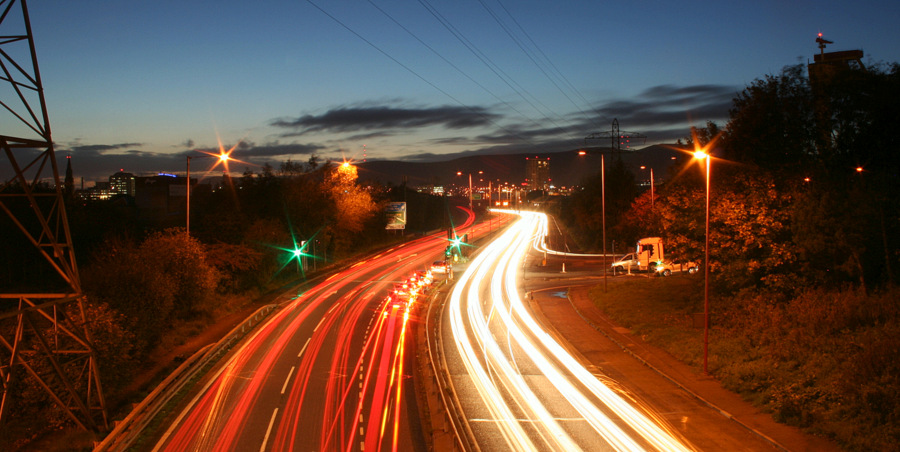
On reading the report that last sentence should be amended to a more accurate “In Belfast, roadworks on the M2 as a result of a road improvement scheme contributed to drivers across the city sitting idle for just less than an hour more in 2015 than in 2014.”
Still, the average driver wasting 38 hours in congestion in Belfast each year is scandalous, right? Well, that depends.
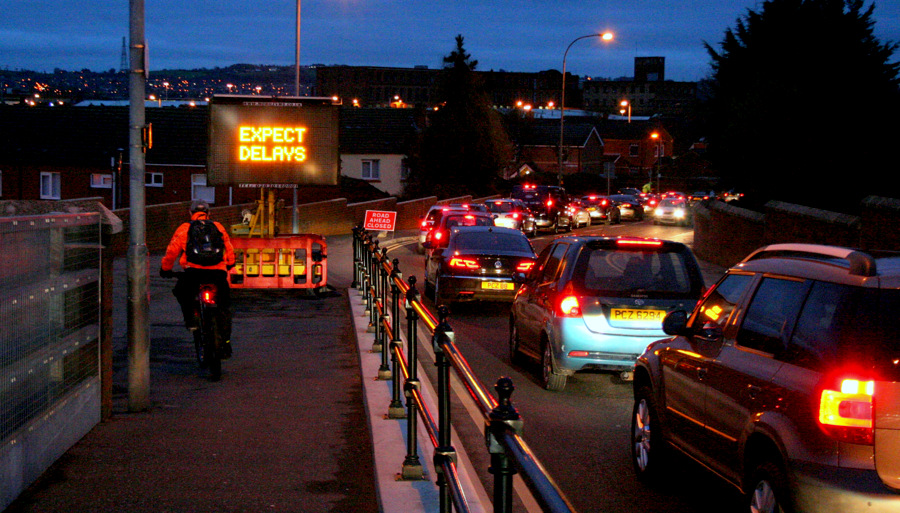
A whopping 68% of Belfast workers take the car to work. That is scandalous. It’s 84% across Northern Ireland, and that higher level is important as around half of employee jobs in Belfast are filled by people travelling from outside the city every day.
Of the average 908 journeys we all make each year, a hefty 41% are made either as a car driver or passenger on trips of less than 5 miles. That is scandalous.
We should also take a step back and see what the average private vehicle commuter in Northern Ireland thinks about their journey. Interestingly 70% reported no difficulties at all in driving/being driven to work, with only 21% seeing traffic congestion / roadworks as a notable difficulty. Not such a scandal.
Those of us in Belfast smart enough (and in fairness, able to) opt for other ways to get to work (walk, cycle, bus, train and so on) fare much better. 81% of us have no difficulties at all, and this supposed chronic traffic congestion is only a problem for 4%. What scandal?
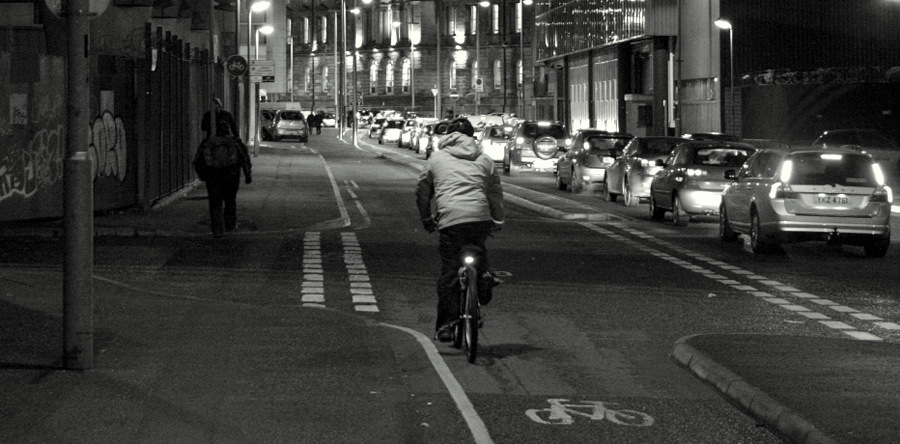
And to top it all, 36% of households in Belfast don’t have access to a car at all – which makes you wonder why we’re so focused on making the city work for cars rather than all of the people? (Sorry, that doesn’t sell papers. My bad.)
There’s also the issue of the INRIX methodology, which appears a little more complex that the recurring TomTom survey which gets everyone in Belfast agitated each year, but seems to boil down to a similar idea – take a free-flow (quietest period) reading and compare it to the most congested (rush hour period) reading and assess the difference.
Which is fine, except that for decades Belfast has been busy designing a road network primarily to maximise capacity at rush hour with it’s near-motorway standard urban ring road, wide arterials and an almost non-existent inner-city resident population that means for most of the day, roads are fairly clear. Then at rush hour EVERYONE seems to be on the road heading into or out of the city centre and one little prang can gum up the whole system.
You lack imagination if u consider #space4cycling impossible on Belfast's narrow (I count 6 cars wide) arterial roads pic.twitter.com/sWaZIDmMaG
— NI Greenways (@nigreenways) August 28, 2014
So I can read it as either Belfast has shockingly jammed rush hours (it doesn’t) or incredibly quiet off-peak periods (well yes, yes it does now you mention it) which can skew the results. I dare anyone who’s set foot outside of Northern Ireland and experienced a really big city to tell me (with a straight face) that Belfast has a traffic problem.
Let’s put this all into a little context with the DRD Northern Ireland Travel Survey:
Approximately 33 minutes per day were spent travelling by car (averaging just over eight days per year).
Yes, we all spend EIGHT days of our lives each year in cars. WE SPEND TOO MUCH TIME IN OUR CARS. And all we’ve learned from INRIX is that just over a day and a half of that is going slower than we’d like BECAUSE TOO MANY OF US SPEND TOO MUCH TIME IN OUR CARS.
But the Nolans and the Belfast Telegraphs and UKIPs will distract us all with a fevered debate about bus lanes (and cycle lanes to a lesser extent) which are definitely what’s grinding everything to a halt.
As anticipated – here’s the Stephen Nolan Show on the morning of 16th March with SDLP’s Claire Hanna and UKIP’s Bob Stoker.
[gigya src=”https://d15mj6e6qmt1na.cloudfront.net/cdn/embed_player.swf” style=”background-color:transparent; display:block; max-width: 700px;” flashvars=”image_option=small&imgURL=https%3A%2F%2Fd15mj6e6qmt1na.cloudfront.net%2Fi%2F20479561%2F300x300%2Fc&link_color=%2358d1eb&mp3Author=The+Nolan+Show&mp3Duration=1144060.0&mp3LinkURL=https%3A%2F%2Faudioboom.com%2Fboos%2F4308474-is-the-ormeau-road-northern-ireland-s-slowest-at-3-7mph-clairehanna-says-it-is&mp3Time=09.59am+16+Mar+2016&mp3Title=Is+the+Ormeau+Road+Northern+Ireland%E2%80%99s+slowest+at+3.7mph%3F+%40ClaireHanna+says+it+is+&mp3URL=https%3A%2F%2Faudioboom.com%2Fboos%2F4308474-is-the-ormeau-road-northern-ireland-s-slowest-at-3-7mph-clairehanna-says-it-is.mp3%3Fsource%3Dwordpress&player_theme=light&rootID=boo_player_1&show_title=true&waveimgURL=https%3A%2F%2Fd15mj6e6qmt1na.cloudfront.net%2Fi%2Fw%2F4807966″ width=”100%” height=”150″ allowFullScreen=”true” wmode=”transparent”]
Except, there was congestion before bus lanes. And (whisper this) bus lanes aren’t a congestion-relieving measure, at least in the short term. They’re meant to provide a way to skip past that ever-present congestion. BECAUSE WE DRIVE TOO MANY CARS AT THE SAME TIME.
Or cause “traffic chaos” by looking at a petrol station in our thousands..
Traffic chaos as commuters slow down to look at new M1 Applegreen service station https://t.co/VMcWsXHG5W pic.twitter.com/OWS9Pat1pQ
— Belfast Telegraph (@BelTel) March 11, 2016
You might swallow the headlines, op-eds and angry letters on these reports and think “yeah, let’s scrap bus lanes” or “it’s time to take the roads back for me, the private motorist” but if you take time to actually read the report (who does that – am I right?) it offers some smart solutions which our very own transport department is rolling out.
“As metropolitan economies continue to grow, governments should be prepared to invest in solutions to reduce the inevitable rise in congestion – a condition that can undermine the dynamism, livability, natural beauty, and other qualities that make certain cities so attractive in the first place.
“The problem of congestion cannot be solved simply by adding new roads or fixing the pavement on existing ones. If our cities are to enjoy the benefits of growth without experiencing the myriad ill effects of congestion, they will need to invest in smarter solutions.
“Some of these solutions are tried-and true, such as increased mass transit and other multimodal options, including pedestrian and bicycle programs. Others are more novel, such as the adjustment of traffic-signal intervals based on up-to-the-minute traffic data.”
That’ll be Belfast on the Move, investing in railways and a new Belfast Transport Hub, Belfast Rapid Transit, Park and Ride, Belfast Bike Hire, and the very obvious moves to improve the quality of our city’s bicycle infrastructure. Oh, and our bus lanes are working, which is an inconvenient fact.
But empty column inches and airwaves need filled, as do the less enquiring minds of the motoring public. Let the circus commence..



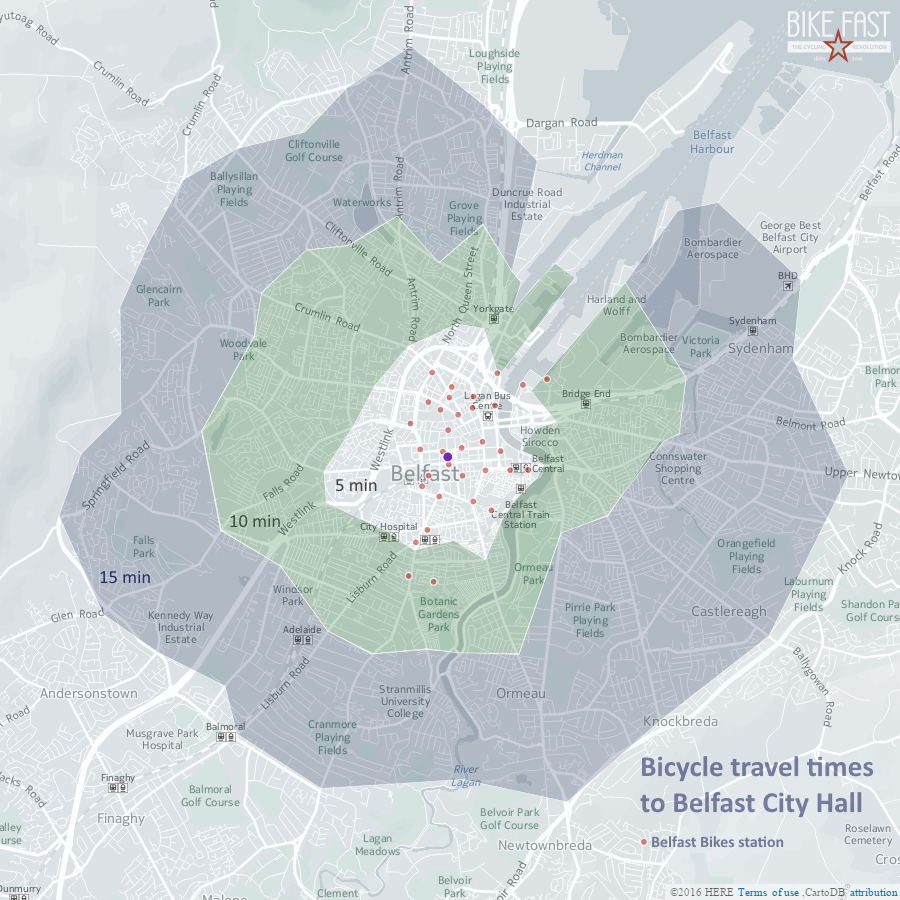

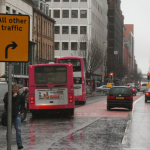
Unlike a lot of European cities which underwent urban renewal via Bomber Command, Belfast’s urban layout is roughly what it had over 100 years ago, there’s no way to fit that much traffic in that small area.
Belfast? Bomber Command? There’s a joke to be made there surely.